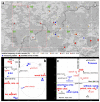VOCs and Odor Episodes near the German-Czech Border: Social Participation, Chemical Analyses and Health Risk Assessment
- PMID: 35162316
- PMCID: PMC8835392
- DOI: 10.3390/ijerph19031296
VOCs and Odor Episodes near the German-Czech Border: Social Participation, Chemical Analyses and Health Risk Assessment
Abstract
People living on both sides of the German-Czech border are subject to episodes of odor air pollution. A joint German-Czech air sampling and risk assessment project was established to identify the substances responsible and their sources. Twenty-four volunteer study participants, 14 from the NW Czech Republic and 10 from Germany (Saxony) reported odors and collected canister samples during sampling periods in winter 2017 and 2018 and autumn 2018. Canister samples and passive samplers were analyzed for volatile organic compounds (VOCs) and passive samplers were analyzed for VOCs and carbonyls. OAVs (Odor Activity Values) and back trajectories were calculated with the aim of identifying the odor sources. Calculated OAVs were in excellent agreement with perceived smells close to an oil processing plant. Odorants identified in fifty canister samples during odor episodes and carbonyl measurements close to the edible oil processing plant were used for health evaluation. Odors reported by participants in Saxony frequently differed from those reported by participants in the Czech Republic. This suggests that certain sources of odor lying on either side of the border only affect that side and not the other with similar considerations regarding health effects. VOCs, including carbonyls, were also sampled at two relatively remote locations during winters of 2017 and 2018; two main sources of odorous compounds were identified at these sites. Analysis of samples taken at sampling sites shows that VOC air pollution and, to a lesser extent carbonyl pollution, originate from both industrial and local sources. Even though levels of sampled substances were not associated with acute effects at any site, long-term exposures to selected compounds could be cause for concern for carcinogenicity at some sites. Odors in Seiffen were associated with carcinogenic compounds in can samples. Although not necessarily representative of long-term exposures to the compounds studied, results such as these suggest that further study is needed to better quantify long-term exposure to potentially harmful compounds, and to either confirm or deny the existence of substantive health risk.
Keywords: GC-MS analysis; canister sampling; health impact; odorous compounds; passive sampling.
Conflict of interest statement
The authors declare no conflict of interest. The funders had no role in the design of the study; in the collection, analyses, or interpretation of data; in the writing of the manuscript, or in the decision to publish the results.
Figures



Similar articles
-
Personal and ambient exposures to air toxics in Camden, New Jersey.Res Rep Health Eff Inst. 2011 Aug;(160):3-127; discussion 129-51. Res Rep Health Eff Inst. 2011. PMID: 22097188
-
[Characterization and Health Risk Assessment of Exposure to Odorous Pollutants Emitted from Industrial Odor Sources].Huan Jing Ke Xue. 2019 Sep 8;40(9):3962-3972. doi: 10.13227/j.hjkx.201901257. Huan Jing Ke Xue. 2019. PMID: 31854858 Chinese.
-
Investigation of health risk assessment and odor pollution of volatile organic compounds from industrial activities in the Yangtze River Delta region, China.Ecotoxicol Environ Saf. 2021 Jan 15;208:111474. doi: 10.1016/j.ecoenv.2020.111474. Epub 2020 Oct 28. Ecotoxicol Environ Saf. 2021. PMID: 33129119
-
Volatile organic compounds at swine facilities: a critical review.Chemosphere. 2012 Oct;89(7):769-88. doi: 10.1016/j.chemosphere.2012.04.061. Epub 2012 Jun 7. Chemosphere. 2012. PMID: 22682363 Review.
-
Organic compounds in office environments - sensory irritation, odor, measurements and the role of reactive chemistry.Indoor Air. 2006 Feb;16(1):7-19. doi: 10.1111/j.1600-0668.2005.00393.x. Indoor Air. 2006. PMID: 16420493 Review.
References
-
- Nicell J.A. Expressions to relate population responses to odor concentration. Atmos. Environ. 2003;37:4955–4964. doi: 10.1016/j.atmosenv.2003.08.028. - DOI
-
- Douša J. Comparison access to odor problems in selected European countries. Inżynieria Miner. 2019;21:83–87. doi: 10.29227/IM-2019-01-15. - DOI
-
- Zheng J., Yu Y., Mo Z., Zhang Z., Wang X., Yin S., Peng K., Yang Y., Feng X., Cai H. Industrial sector-based volatile organic compound (VOC) source profiles measured in manufacturing facilities in the Pearl River Delta, China. Sci. Total Environ. 2013;456:127–136. doi: 10.1016/j.scitotenv.2013.03.055. - DOI - PubMed
-
- Corrêa S.M., Arbilla G. Carbonyl emissions in diesel and biodiesel exhaust. Atmos. Environ. 2008;42:769–775. doi: 10.1016/j.atmosenv.2007.09.073. - DOI
Publication types
MeSH terms
Substances
LinkOut - more resources
Full Text Sources
Miscellaneous

